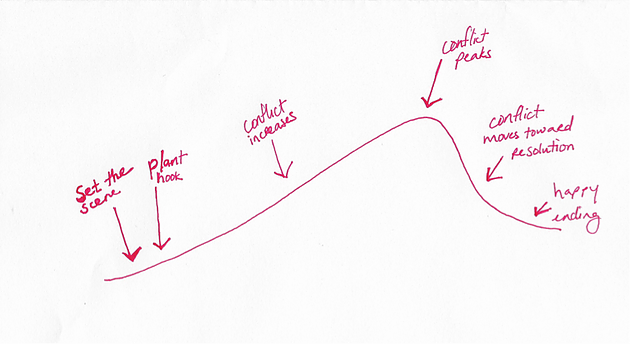February 7, 2017 / Esther Choy

Part Two in a 3-Part Series on interviews. Read Part One and Part Three.
Marathon interviewing is no picnic, as I shared in my last blog on the subject. But once in a blue moon, I came across a candidate I’d just love to talk with beyond the confines of the typical 45-minute interview. When I spoke with this person, I was so immersed in the conversation that lost track of time. How did this interviewee intrigue me so much? She told short, relevant stories throughout the interview. Time and time again, storytelling is what makes the difference to interviewers. “Our brains are just more active when we’re listening to a story,” says Lily Zhang, Assistant Director of Career Counseling & Training at MIT. Storytelling in admissions interviews is the way to razzle and dazzle your audience.
But, in case the advice to “tell stories” still leaves you scratching your head, wondering how to tell a good story in an interview, here are some of my thoughts.
How Long?
First of all, how long should each story be? Too short, and your story won’t be deep enough to connect with your interviewers. Too long, and storytelling in admissions interviews becomes more like rambling or self-indulgence. “One of my first B-school interviews was for Kellogg,” confesses Keith Blume on the Manhattan Prep blog, “and I was looking forward to a long discussion so that the interviewer would get to know me really well. She had to cut off my answer to the first question to move me along to the next question. After that, I adjusted my answers to be much briefer.” Shorter responses worked well for Keith, who went on to graduate with an MBA from Chicago Booth.
Three minutes is the upper limit for stories embedded in interview responses. Your three minutes can roughly correspond to the three-act structure that works well for stories (scene-setting and hook, the journey and then resolution).
No matter what, be sure to plant the hook within the first few seconds—something that will pique the interviewers’ interest and keep them listening for the answer. But don’t forget. Your interviewers know what you’re up to as well. So, don’t string them along for the answers. As you plant the hook, you will also have to get to the point quickly. This is a delicate balancing act.
When in doubt, cut. The time will probably go much more quickly than you expect. Remember, you want your interview to be a dialogue, with give and take just like a conversation.
How Vulnerable?
There is a right level of vulnerability: define it and know it. Admission officers love to hear a genuine failure story, one that displays how you have dusted yourself off and learned from a mistake. But keep in mind that you can’t control how the admissions team will interpret your failure story, so when you tell one, select it with extreme care. You want a story that suggests a lack of experience but never a lack of strong character. For example, the MBA admissions team at Rotman School of Management interviewed a candidate who mentioned that he “procrastinated.”
They had specifically asked him to talk about a negative trait, but “I thought it was probably not a good idea to tell me that,” says admissions interviewer Marie-Eve Roy, “especially for an intensive program like ours.” To make matters worse, the applicants’ references also suggested his tendency to push assignments till the last minute. Rather than reflecting a lack of experience, procrastination, at least to some people, signaled a lack of maturity.
How Heroic?
Don’t paint yourself as the hero all the time. Does that mean you are sometimes the antagonist? No. But there’re plenty of other roles to play:
- Mentor
- Friend
- Sidekick working her way up to heroine
- Witness to an innovation, a discovery, or a transformation.
What Focus Should I Have?
Each story should convey a piece of who you are. Tell the interviewers something new about yourself in each story. One way to prepare for this, a professor recommended, is to “write down the major claims you will make about yourself” and pair each one with a story. For instance, if your claim is “I am a highly collegial team player”—which the professor offers as an example—you should back it up with a concrete story like, “My proudest collaborative achievement so far is my work on Placement Task Force. Let me explain.”
Do I Have to Know All the Answer?
Nope! Never be afraid to say you don’t know. While to you it may feel like you’ve blown your credibility, to your interviewers it simply sounds like you are graciously admitting that you are a finite person. By all means, you must do your research ahead of time. However, your brain is not Google! Admit you don’t know; but promise you will get back to your interviewer. And by doing so, you give yourself a perfect excuse to follow up.
It’s Real Life—Should There Be a Plot?
Yes. Choosing a plot helps you structure your story. Not only that, plots help build rapport with your interviewers. Paul Zak, a neuroeconomist at Claremont Graduate University, studied the human brain’s responses to stories and found that happy endings prompt the brain to release dopamine, leading to euphoria. He also found that little to no chemical response resulted when stories failed to follow this classic arc: 
Here are several classic plots that work well for storytelling in admissions interviews. Best yet, they can be structured according to this arc:
Origin: Places the most emphasis not so much on how you overcame later obstacles, years down the road, but on how you started.
Rebirth: Also known as a “turnaround” story. Maybe you didn’t have the most focused freshman year of college—but then you found the right major and were “reborn.”
Rags to Riches: A story that shows your humble beginnings, in contrast to your current success. This is also commonly known as the Underdog Story.
Voyage and Return: A story of returning to your roots or suddenly realizing that what matters to you now is actually what has always mattered to you.
Overcoming the Monster: An unexpected challenge comes your way, and now you have to tackle it.
Quest: You desperately want something. The “quest” plot tells the story of how you achieved it, despite all the obstacles in your path. In my book, Let the Story Do the Work, I map these out further and provide templates, and many more that are useful for storytelling in admissions interviews, job interviews and more.
Schedule a complimentary communication training consultation today. For more tips and insights on storytelling, sign up for our monthly guide.
Story arc image: Leadership Story Lab
Better Every Story
Leadership Transformation through Storytelling
"This is an amazing and insightful post! I hadn’t thought of that so you broadened my perspective. I always appreciate your insight!" - Dan B.
Get Esther Choy’s insights, best practices and examples of great storytelling to your inbox each month.


